WBR1D Module Datasheet
Last Updated on : 2025-07-29 07:52:13download
WBR1D is a low-power embedded Wi-Fi module that Tuya has developed. It consists of a highly integrated wireless RF chip (W701D-VA1-CG), a few peripherals, a built-in Wi-Fi network protocol stack, the Bluetooth network protocol, and varied library functions.
Overview
WBR1D has an embedded low-power 32-bit CPU, 512-KB SRAM, 4-MB flash memory, and rich peripherals.
WBR1D is an RTOS platform that integrates all function libraries of the Wi-Fi MAC and TCP/ IP. You can develop embedded Wi-Fi products as required.
Features
- Embedded low-power 32-bit CPU, which can also function as an application processor
- The maximum clock rate: 200 MHz
- Operating voltage: 3.3 V
- Peripherals: 6 GPIOs, 1 UART, 1 UART (which can display log information and be used for debugging), and 1 ADC
- Wi-Fi connectivity
- 802.11 a/b/g/n 1x1, 2.4 G&5 G
- Channels 1 to 14@2.4 GHz; channels 36 to 177@5 GHz
- Support WEP/WPA/WPA2/WPA2 PSK (AES) WPA3 security mode
- Up to +17 dBm output power in 802.11b mode; up to +15 dbm output power in 802.11a mode
- Support STA/AP/STA+AP working mode
- Support SmartConfig and AP network configuration manners for Android and iOS devices
- Onboard PCB antenna with a gain of 2 dBi@2.4 G or 2.6 dBi@5 G
- Operating temperature: -20℃ to 85℃
- Bluetooth LE connectivity
- Support Bluetooth LE V5.0
- Up to +9 dBm output power
- PCB antenna with a gain of 2 dBi@2.4 G, which is shared by Wi-Fi and Bluetooth
- Operating temperature: -20℃ to 85℃
Applications
- Intelligent building
- Smart household and home appliances
- Smart socket and light
- Industrial wireless control
- Baby monitor
- Network camera
- Intelligent bus
Module interfaces
Dimensions and footprint
WBR1D has two lines of pins with a pin spacing of 1.5±0.1 mm.
The WBR1D dimensions are 18±0.35 mm (W)×23.5±0.35 mm (L)×2.8±0.15 mm (H).
Diagram of dimensions of WBR1D
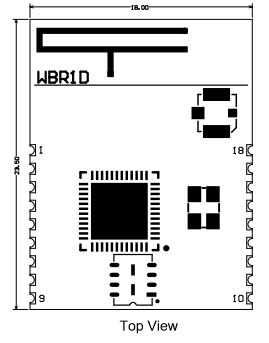
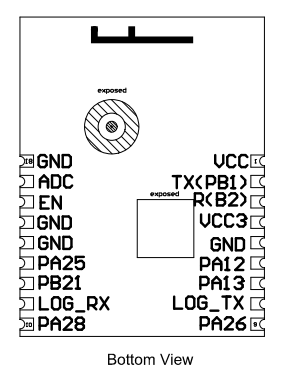
Pin definition
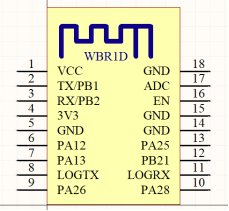
| Pin number | Symbol | I/O type | Function |
|---|---|---|---|
| 1 | VCC | P | The internal level conversion circuit supplies power to the input pin and the actual voltage is the voltage uploaded by the user’s backplane |
| 2 | TX/PB1 | I/O | User-side serial interface TXD signal |
| 3 | RX/PB2 | I/O | User-side serial interface RXD signal |
| 4 | 3V3 | P | Power supply pin (3.3V) |
| 5 | GND | P | Power supply reference ground |
| 6 | PA12 | I/O | Support hardware PWM function and correspond to PA 12 of IC |
| 7 | PA13 | I/O | Support hardware PWM function and correspond to PA 13 of IC |
| 8 | LOGTX | I/O | LOG serial interface output pin (used to display the internal information of the module) |
| 9 | PA26 | I/O | Common IO pin, which corresponds to PA 26 of IC |
| 10 | PA28 | I/O | Support hardware PWM function and correspond to PA 28 of IC |
| 11 | U0RX | I/O | LOG serial interface input pin |
| 12 | PB21 | I/O | Common IO pin, which corresponds to PB 21 of IC |
| 13 | PA25 | I/O | Support hardware PWM function and correspond to PA 25 of IC |
| 14 | GND | P | Power supply reference ground |
| 15 | GND | P | Power supply reference ground |
| 16 | EN | I/O | External reset signal |
| 17 | ADC | AI | ADC port |
| 18 | GND | P | Power supply reference ground |
- P indicates power supply pins, I/O indicates input/output pins and AI indicates analog input pins.
- RST is only a hardware reset pin and cannot be used for clearing information about Wi-Fi network configuration.
Definitions on test points
| Pin number | Symbol | I/O type | Function |
|---|---|---|---|
| - | TEST | I | Be used for the production test of the module |
Test pins are not recommended.
Electrical parameters
Absolute electrical parameters
| Parameter | Description | Minimum value | Maximum Value | Unit |
|---|---|---|---|---|
| Ts | Storage temperature | -20 | 85 | ℃ |
| VBAT | Power supply voltage | 3.0 | 3.6 | V |
| ESD voltage (human body model) | TAMB-25℃ | - | 2 | KV |
| ESD voltage (machine model) | TAMB-25℃ | - | 0.5 | KV |
Normal working conditions
| Parameter | Description | Minimum value | Typical Value | Maximum Value | Unit |
|---|---|---|---|---|---|
| Ta | Operating temperature | -20 | - | 85 | ℃ |
| VBAT | Power supply voltage | 3.0 | 3.3 | 3.6 | V |
| VIL | IO low-level input | -0.3 | - | VCC*0.25 | V |
| VIH | IO high-level input | VCC*0.75 | - | VCC | V |
| VOL | IO low-level output | - | - | VCC*0.1 | V |
| VOH | IO high-level output | VCC*0.8 | - | VCC | V |
| Imax | IO drive current | - | - | 12 | mA |
TX and RX power consumption
Transmission and receiving at 2.4G
| Working status | Mode | Rate | Transmit power/Receive | Typical value | Unit |
|---|---|---|---|---|---|
| Transmit | 11 b | 11Mbps | +18dBm | 250 | mA |
| Transmit | 11g | 54Mbps | +17dBm | 180 | mA |
| Transmit | 11n-HT20 | MCS7 | +16dBm | 170 | mA |
| Transmit | 11n-HT40 | MCS7 | +16dBm | 150 | mA |
| Receive | 11b | 11Mbps | Constantly receive | 70 | mA |
| Receive | 11g | 54Mbps | Constantly receive | 72 | mA |
| Receive | 11n-HT20 | MCS7 | Constantly receive | 70 | mA |
| Receive | 11n-HT40 | MCS7 | Constantly receive | 73 | mA |
Transmission and receiving at 5G
| Working Status | Mode | Rate | Transmit Power/Receive | Typical Value | Unit |
|---|---|---|---|---|---|
| Transmit | 11a | 54Mbps | +15dBm | 300 | mA |
| Transmit | 11n-HT20 | MCS7 | +15dBm | 230 | mA |
| Transmit | 11n-HT40 | MCS7 | +14dBm | 220 | mA |
| Receive | 11a | 54Mbps | Constantly receive | 71 | mA |
| Receive | 11n-HT20 | MCS7 | Constantly receive | 72 | mA |
| Receive | 11n-HT40 | MCS7 | Constantly receive | 76 | mA |
Operating current
| Working mode | Working status, TA = 25°C | Average value | Peak value (Typical value) | Unit |
|---|---|---|---|---|
| Fast network configuration (AP) | The module is in fast network configuration state and the Wi-Fi indicator flashes slowly. | 45.7 | 688 | mA |
| Fast network configuration (Bluetooth) | The module is in Bluetooth pairing state and the Wi-Fi indicator flashes fast. | 44.2 | 607 | mA |
| No operation during network connection | The module is in an idle networking working state and the Wi-Fi indicator is always on. | 41.8 | 368 | mA |
| Operations are being performed during network connection | The module is in a networked operational state and the Wi-Fi indicator is always on. | 45.4 | 376 | mA |
| Weak network state | The module is in a wireless signal weak network connection working state and the Wi-Fi indicator is off. | 45.5 | 376 | mA |
| Disconnected state | The module is disconnected and the Wi-Fi indicator is off. | 43.3 | 360 | mA |
| The router is not powered | The module is in a working state where the router is powered off and disconnected from the internet and the Wi-Fi indicator is off. | 58.6 | 368 | mA |
The above data module is powered by a DC steady-state power supply at 3.3 V and is based on the Tuya single-plug firmware, with firmware version v1.0.4. Test data may vary slightly due to differences in firmware versions, modules, and power supplies.
RF parameters
Basic RF features
| Parameter | Description |
|---|---|
| Working frequency | 2.412 to 2.484 GHz; 5.180 to 5.885 GHz |
| Wi-Fi standard | IEEE 802.11 a/b/g/n (Channels 1 to 14; channels 36 to 177) |
| Data transmission rate | 11b: 1, 2, 5.5, 11 (Mbps) 11 a/g: 6, 9, 12, 18, 24, 36, 48, 54 (Mbps) 11n: HT20 MCS 0 to 7, HT40 MCS 0 to 7 |
| Antenna Type | PCB antenna with a gain 2 dBi@2.4 G; PCB antenna with a gain 2.6 dBi@5 G |
TX performance
2.4G TX performance
| Parameter | Minimum Value | Typical Value | Maximum Value | Unit |
|---|---|---|---|---|
| Average RF output power, 802.11b CCK Mode 11M | - | 17 | - | dBm |
| Average RF output power, 802.11g OFDM Mode 54M | - | 16 | - | dBm |
| Average RF output power, 802.11n HT20 Mode MCS7 | - | 15 | - | dBm |
| Average RF output power, 802.11n HT40 Mode MCS7 | - | 14 | - | dBm |
| Frequency error | -10 | - | 10 | ppm |
5G-TX performance
| Parameter | Minimum Value | Typical Value | Maximum Value | Unit |
|---|---|---|---|---|
| Average RF output power, 802.11a OFDM Mode 54M | - | 15 | - | dBm |
| Average RF output power, 802.11n HT20 Mode MCS7 | - | 14 | - | dBm |
| Average RF output power, 802.11n HT40 Mode MCS7 | - | 13 | - | dBm |
| Frequency error | -10 | - | 10 | ppm |
RX performance
RX sensitivity
| Parameter | Minimum Value | Typical Value | Maximum Value | Unit |
|---|---|---|---|---|
| PER<8%, RX sensitivity, 802.11b DSSS Mode 11M | - | -91 | - | dBm |
| PER<10%, RX sensitivity, 802.11a/g OFDM Mode 54M | - | -75 | - | dBm |
| PER<10%, RX sensitivity, 802.11n OFDM Mode HT20-MCS7 | - | -72 | - | dBm |
Antenna
Antenna type
WBR1D uses only an onboard PCB antenna.
Antenna interference reduction
To ensure the optimal Wi-Fi performance when the Wi-Fi module uses an onboard PCB antenna, it is recommended that the antenna be at least 15 mm away from other metal parts.
To ensure antenna performance, the PCB should not be routed or clad with copper in the antenna area. The main points of the layout: 1. Make sure that there is no substrate medium directly below or above the printed antenna. 2. Make sure that the area around the printed antenna is far away from the metal copper skin, so as to ensure the radiation effect of the antenna to the greatest extent.
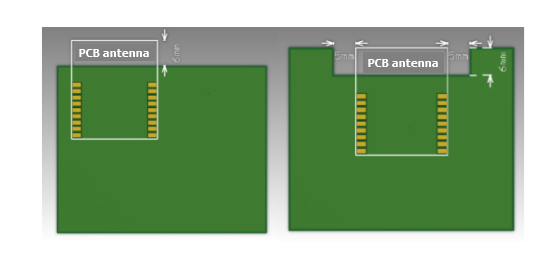
For the antenna area of the PCB of the module, refer to the diagram of Mechanical Dimensions.
Power-on sequence and resetting
Power-on sequence
The RTL8720DN chip has requirements on the power-on sequence. It is recommended that the voltage rises from 0 to 3.3V within 40ms.
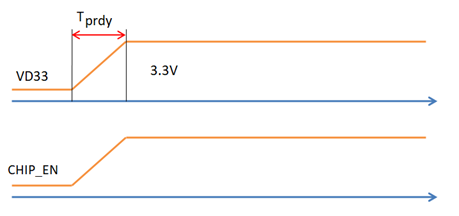
| Symbol | Parameter | Minimum | Typical | Maximum | Unit |
|---|---|---|---|---|---|
| TPRDY | 3.3V ready time | 0.6 | 40 | ms | |
| CHIP_EN | CHIP_EN ready time | 0.6 | 40 | ms |
Resetting
When designing a plate of a module, you should reserve a reset IC on the pin CHIP_EN. The preferable type of IC is BL8506-27CRO. The IC is packaged in the form of SOT23. Refer to the circuit in the following figure (R30 is reserved and may not be mounted).
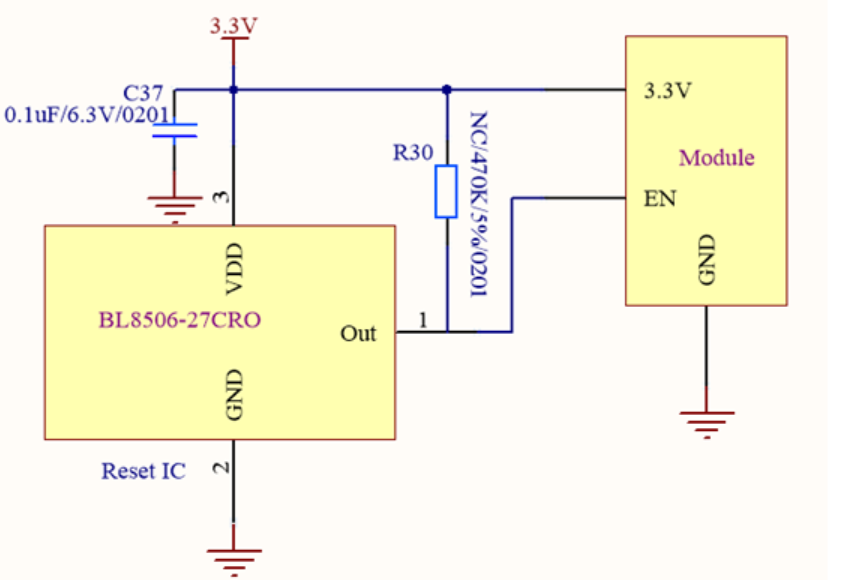
Treatment of GPIO
A few pins (PA 12, PA 13, PA 15, PA 25, PA 28, and PA 26) of the module will have instantaneous high-level pulses before the chip fully works, and everything will be normal after the chip works. For these pins, if they are directly used as driving light sources or relays, in order to avoid the effect of burrs at the moment of power-on, refer to the following processing:
Pull down a 1K resistor at an output port of a pin, and then connect a diode in series. In this case, the voltage of a GPIO will drop to about 2.7V after passing through the diode. The red box represents the original drive tube on the customer’s baseboard. A diode D1 and pull-down 1-KΩ resistor need to be added.
If a lamp is directly driven, pull down a 10-KΩ resistor on the grid of the positive MOS. If a lamp is not directly driven and a PWM signal will not be sent until the module is officially launched, there is no need to add a pull-down resistor and diode.
If a relay is driven, you can change the diode to a resistor of 0 Ω according to the actual situation.
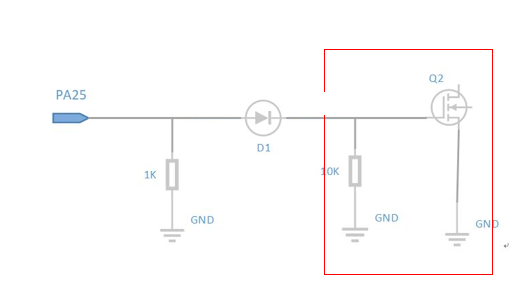
Packaging information and production instructions
Mechanical dimensions
The PCB dimensions are 18±0.35 mm (W)×23.5±0.35 mm(L)×0.8 ±0.1mm (H)
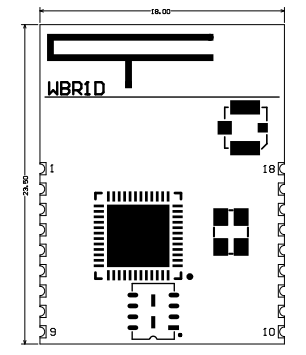 g)
g)
Side view

Schematic diagram of packaging
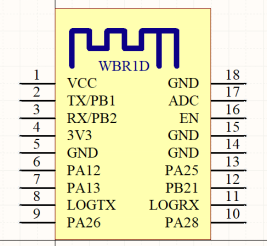
Diagram of PCB package
Optionally, WBR1D can be mounted by the SMT.
PCB package diagram-SMT
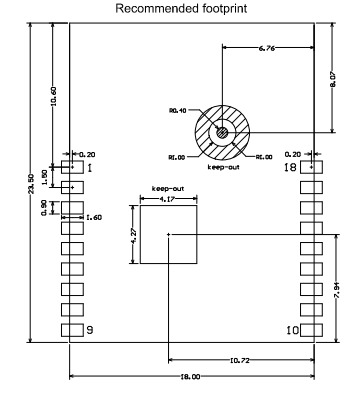
The area indicated as keep-out in the diagram above does not require tinning and should not have any traces routed through it.
Production instructions
-
The Tuya SMT module should be mounted by the SMT device. After being unpacked, it should be soldered within 24 hours. Otherwise, it should be put into the drying cupboard where the RH is not greater than 10%; or it needs to be packaged under vacuum again and the exposure time needs to be recorded (the total exposure time cannot exceed 168 hours).
- SMT devices:
- Mounter
- SPI
- Reflow soldering machine
- Thermal profiler
- Automated optical inspection (AOI) equipment
- Baking devices:
- Cabinet oven
- Anti-electrostatic and heat-resistant trays
- Anti-electrostatic and heat-resistant gloves
- SMT devices:
-
Storage conditions for a delivered module:
-
The moisture-proof bag must be placed in an environment where the temperature is below 40°C and the relative humidity is lower than 90%.
-
The shelf life of a dry-packaged product is 12 months from the date when the product is packaged and sealed.
-
There is a humidity indicator card (HIC) in the packaging bag.
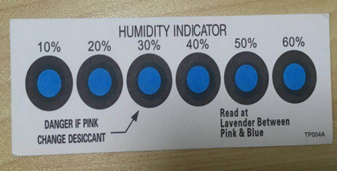
-
-
The module needs to be baked in the following cases:
- The packaging bag is damaged before unpacking.
- There is no HIC in the packaging bag.
- After unpacking, circles of 10% and above on the HIC become pink.
- The total exposure time has lasted for over 168 hours since unpacking.
- More than 12 months have passed since the sealing of the bag.
-
Baking settings:
- Temperature: 40°C and ≤ 5% RH for reel package and 125°C and ≤5% RH for tray package (please use the heat-resistant tray rather than a plastic container)
- Time: 168 hours for reel package and 12 hours for tray package
- Alarm temperature: 50°C for reel package and 135°C for tray package
- Production-ready temperature after natural cooling: < 36°C
- Re-baking situation: If a module remains unused for over 168 hours after being baked, it needs to be baked again.
- If a batch of modules is not baked within 168 hours, do not use the wave soldering to solder them. Because these modules are Level-3 moisture-sensitive devices, they are very likely to get damp when exposed beyond the allowable time. In this case, if they are soldered at high temperatures, it may result in device failure or poor soldering.
-
In the whole production process, take electrostatic discharge (ESD) protective measures.
-
To guarantee the passing rate, it is recommended that you use the SPI and AOI to monitor the quality of solder paste printing and mounting.
Recommended oven temperature curve
Set oven temperatures according to the following temperature curve of reflow soldering. The peak temperature is 245°C.
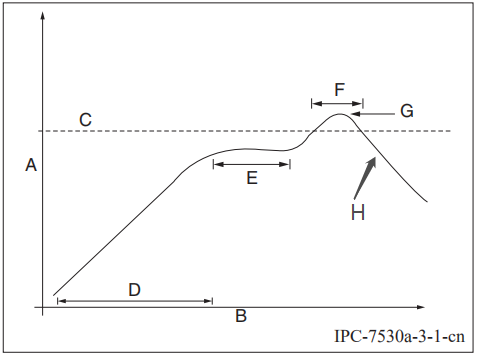
- A: Temperature axis
- B: Time axis
- C: Liquidus temperature: 217 to 220°C
- D: Ramp-up slope: 1 to 3°C/s
- E: Duration of constant temperature: 60 to 120s; the range of constant temperature: 150 to 200°C
- F: Duration above the liquidus: 50 to 70s
- G: Peak temperature: 235 to 245°C
- H: Ramp-down slope: 1 to 4°C/s
The above curve is just an example of the solder paste SAC305. For more details about other solder pastes, please refer to Recommended oven temperature curve in the solder paste specifications.
Storage conditions
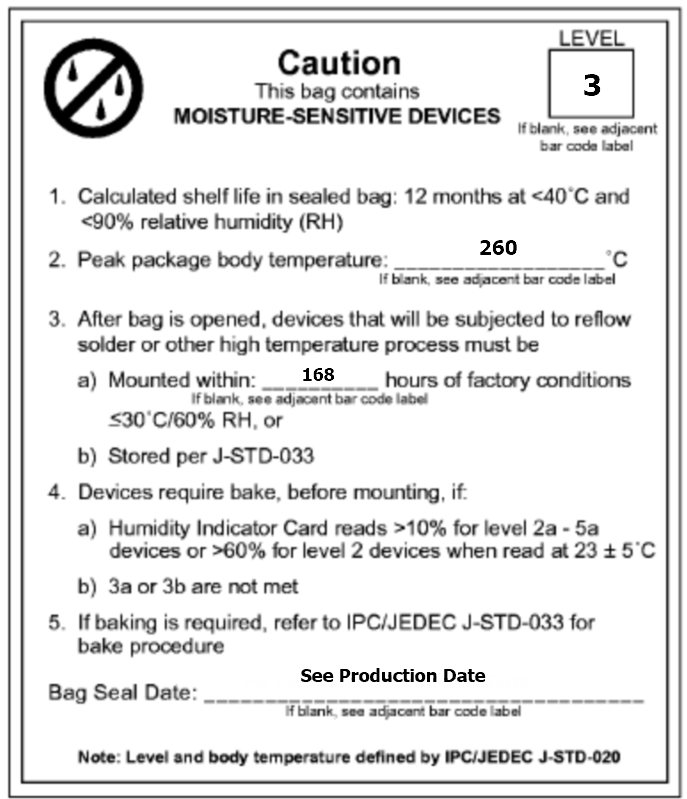
MOQ and packaging information
| Product model | MOQ (pcs) | Packing method | The number of modules per reel | The number of reels per carton |
|---|---|---|---|---|
| WBR1D | 4000 | Tape reel | 1000 | 4 |
Appendix-Statement
FCC Caution: Any changes or modifications not expressly approved by the party responsible for compliance could void the user’s authority to operate this device.
This device complies with Part 15 of the FCC Rules. Operation is subject to the following two conditions: (1) This device may not cause harmful interference, and (2) this device must accept any interference received, including interference that may cause undesired operation.
Note: This device has been tested and found to comply with the limits for a Class B digital device, according to part 15 of the FCC Rules. These limits are designed to provide reasonable protection against harmful interference in a residential installation. This device generates, uses, and can radiate radio frequency energy and, if not installed and used following the instructions, may cause harmful interference to radio communications. However, there is no guarantee that interference will not occur in a particular installation.
If this device does cause harmful interference to radio or television reception, which can be determined by turning the device off and on, the user is encouraged to try to correct the interference by one or more of the following measures:
- Reorient or relocate the receiving antenna.
- Increase the separation between the device and receiver.
- Connect the device to an outlet on a circuit different from that to which the receiver is connected.
- Consult the dealer or an experienced radio/TV technician for help.
Radiation Exposure Statement
This device complies with FCC radiation exposure limits set forth for an uncontrolled rolled environment. This device should be installed and operated with a minimum distance of 20cm between the radiator and your body.
Important Note
This radio module must not be installed to co-locate and operate simultaneously with other radios in the host system except following FCC multi-transmitter product procedures. Additional testing and device authorization may be required to operate simultaneously with other radios.
The availability of some specific channels and/or operational frequency bands are country-dependent and are firmware programmed at the factory to match the intended destination. The firmware setting is not accessible by the end-user.
The host product manufacturer is responsible for compliance with any other FCC rules that apply to the host not covered by the modular transmitter grant of certification. The final host product still requires Part 15 Subpart B compliance testing with the modular transmitter installed.
The end-user manual shall include all required regulatory information/warnings as shown in this manual, including “This product must be installed and operated with a minimum distance of 20 cm between the radiator and user body”.
This device has got an FCC ID: 2ANDL-WBR1D. The end product must be labeled in a visible area with the following: “Contains Transmitter Module FCC ID: 2ANDL-WBR1D”.
This device is intended only for OEM integrators under the following conditions:
The antenna must be installed such that 20cm is maintained between the antenna and users, and the transmitter module may not be co-located with any other transmitter or antenna.
As long as the 2 conditions above are met, further transmitter tests will not be required. However, the OEM integrator is still responsible for testing their end-product for any additional compliance requirements required with this module installed.
Declaration of Conformity European Notice

Hereby, Hangzhou Tuya Information Technology Co., Ltd declares that this module product is in compliance with essential requirements and other relevant provisions of Directive 2014/53/EU,2011/65/EU. A copy of the Declaration of conformity can be found at https://www.tuya.com.

This product must not be disposed of as normal household waste, in accordance with the EU directive for waste electrical and electronic equipment (WEEE-2012/19/EU). Instead, it should be disposed of by returning it to the point of sale, or to a municipal recycling collection point.
The device could be used with a separation distance of 20cm to the human body.
The device is restricted to indoor use only when operating in the 5250 to 5350 MHz frequency range.

Is this page helpful?
YesFeedbackIs this page helpful?
YesFeedback





